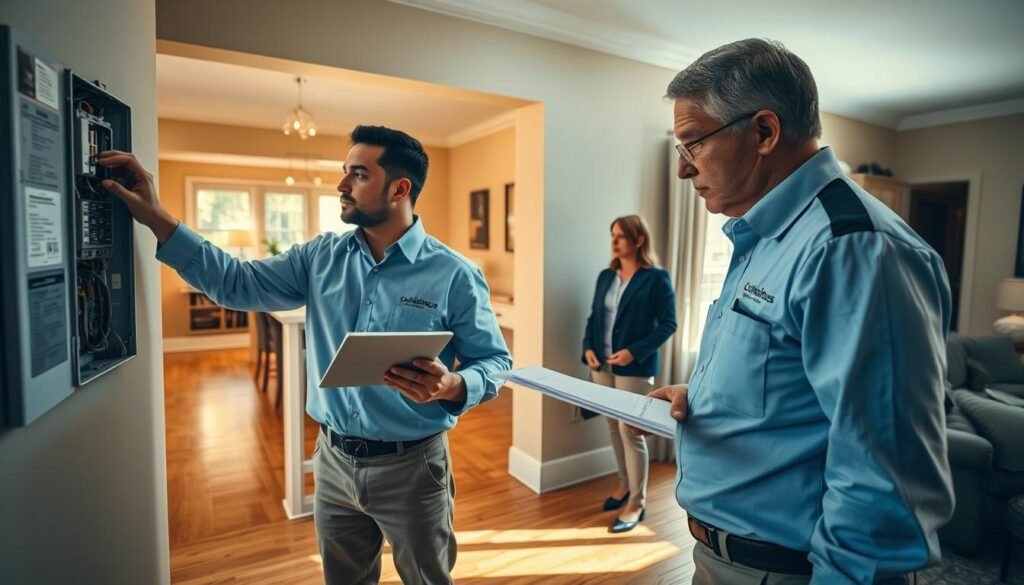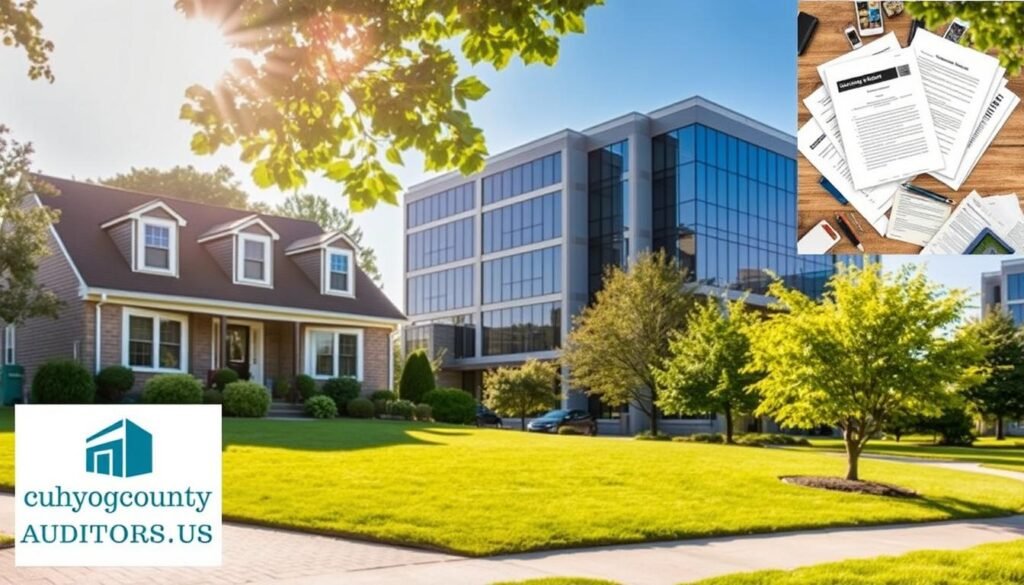Did you know that property assessments in Cuyahoga County can significantly impact your tax obligations? Knowing the difference between residential and commercial property assessments is key. It affects how much you pay in taxes.
Jason, an expert auditor at CuyahogaCountyAuditors.us, offers valuable insights. He helps property owners understand the complex world of property evaluations.
It’s important to know how your property is assessed. This knowledge is vital for both homeowners and business owners. It helps you plan and might even lower your taxes.
Key Takeaways
- Property assessments in Cuyahoga County vary between residential and commercial properties.
- Understanding these differences is key for managing tax obligations.
- Expert insights from auditors like Jason are very helpful.
- Accurate property evaluations are essential for fair taxes.
- Knowing how assessments affect your finances is beneficial.
Understanding Property Assessments in Cuyahoga County
Property assessments in Cuyahoga County are key to figuring out property tax assessments. It’s important for property owners to understand this process. The county auditor’s office does these assessments, which help fund local public services.
The Role of the County Auditor in Property Assessments
The Cuyahoga County Auditor is in charge of assessing properties. They make sure both homes and businesses are valued correctly. The auditor’s office keeps records of who owns what and how much it’s worth.
Why Property Assessments Matter to Your Bottom Line
Knowing about property tax assessments is vital. They affect how much you pay in taxes. Fair assessments help everyone contribute to local services like schools and police.
How Assessment Values Impact Your Property Rights
The value of your property can change your real estate evaluation. It might affect your rights, like when you sell or refinance. Understanding how values are set can help you make better decisions.
Residential vs. Commercial Property Assessments in Cuyahoga County
Assessing residential and commercial properties in Cuyahoga County has its own rules and methods. Knowing these differences helps property owners deal with assessments better.
Basic Definitions and Property Classifications
Residential properties in Cuyahoga County are homes, condos, or places for personal use. Residential real estate assessments look at the market value. They consider location, size, and condition.
Commercial properties include office buildings, retail spaces, and industrial sites for business. Commercial property appraisals look at income, expenses, and market trends to value them.
Key Distinctions Between Assessment Types
The main difference is how they value properties. Residential assessments use recent sales of similar homes.
Commercial assessments use the income capitalization approach. They look at income and expenses to value properties. This is key for income-generating properties.
Legal Framework Governing Different Property Types
Cuyahoga County’s property assessments follow Ohio state law. Property assessment companies must follow these rules.
It’s important for property owners to know the legal framework. This ensures fair assessments and follows state and county rules.
The Assessment Cycle in Cuyahoga County
Knowing the assessment cycle in Cuyahoga County is key for property owners. It helps them understand their tax duties better. The county updates and reappraises properties regularly to keep values accurate.
Triennial Updates and Sexennial Reappraisals Explained
Cuyahoga County has a cycle of triennial updates and sexennial reappraisals. Triennial updates adjust values every three years based on the market. Sexennial reappraisals revalue all properties every six years. This keeps assessments fair and up-to-date.
The triennial update process includes:
- Adjusting values based on recent sales
- Looking at neighborhood changes
- Reflecting market trends
Sexennial reappraisals, though, are more detailed. They involve inspections and revaluations with the latest market data.
Current Assessment Timeline for Property Owners
Property owners in Cuyahoga County need to know the current timeline. The county auditor’s office shares details on upcoming dates and deadlines. Owners can expect:
- Notices of assessment changes
- Chances to appeal assessments
- Deadlines for appeals
Keeping up with these timelines is vital for managing assessments well.
How to Prepare for Upcoming Assessment Periods
To get ready for assessment periods, property owners should:
- Check their property’s assessment history
- Collect important documents like appraisals or sales data
- Keep an eye on local market trends
Being proactive helps ensure properties are assessed correctly. It also prepares owners for any tax changes.
Residential Property Assessment Methodology
Knowing how homes are assessed in Cuyahoga County is key for homeowners. The assessment aims to be fair and accurate in setting property values.
Market Approach for Residential Properties
The market approach is a common way to assess homes. It looks at recent sales of similar homes in the area to find a fair value. This method works well in Cuyahoga County, where residential property appraisal firms use local market trends.
Comparable Sales Analysis Process
This process finds recent sales of homes like the one being assessed. It helps set a benchmark for the home’s value.
Key Factors Affecting Residential Property Values
Many things affect home values in Cuyahoga County. These include the home’s condition, where it’s located, and recent sales of similar homes. Homeowners should know these factors when looking at their residential property valuation.
How Neighborhood Comparables Impact Your Assessment
Neighborhood sales data is key in assessing homes. It helps assessors understand cuyahoga county real estate values. Homeowners can learn how these sales affect their assessment by talking to a trusted property assessment company ohio.
Commercial Property Assessment Methodology
Assessing commercial properties in Cuyahoga County is complex. It involves different valuation methods. Knowing these methods is key for property owners to deal with taxes.
Income Capitalization Approach
The income capitalization method is common for commercial property assessment. It calculates a property’s value by capitalizing its net operating income (NOI). NOI is found by subtracting expenses from the property’s income.
Net Operating Income Calculations
To find NOI, start with the property’s gross income. This includes all income from the property. Then, subtract expenses like maintenance and utilities. The remaining amount is the NOI, which is then valued based on the property’s risk and income prospects.
Cost Approach for Specialized Properties
The cost approach is best for unique commercial properties. It estimates the cost to rebuild or replace the property, minus depreciation, plus land value. This method is good for properties that don’t earn income through rent.
Market Analysis for Commercial Real Estate
Market analysis is vital in assessing commercial properties. Assessors look at sales of similar properties to find a property’s market value. This helps understand market trends and their effect on property values.
Here’s a simple example of how different factors affect commercial property assessment:
| Property Type | Assessment Method | Key Factors |
|---|---|---|
| Office Buildings | Income Capitalization | NOI, Capitalization Rate |
| Industrial Facilities | Cost Approach | Replacement Cost, Depreciation |
| Retail Centers | Market Analysis | Comparable Sales, Market Trends |
Understanding these methods and their application in Cuyahoga County is important. It helps property owners manage their taxes better. Staying informed about assessment factors is essential.
Property Inspection Process Differences
The way property inspections are done changes a lot between homes and businesses. Knowing these differences helps property owners understand the assessment process better.
What to Expect During a Residential Inspection
Inspectors look at the property’s condition and features during a home inspection. They check the size, age, and any upgrades. They also look at the neighborhood and compare it to similar homes. Residential inspections focus on the overall condition and livability of the property.

Commercial Property Inspection Procedures
Commercial property inspections are more detailed. Inspectors check the property’s physical state and its ability to make money. They look at rental income, operating costs, and market demand. This helps figure out the property’s value based on its commercial use.
Documentation Requirements by Property Type
The documents needed for inspections vary between homes and businesses. Homes need records of similar sales and details about the property’s state. Businesses need more, like financial reports, lease agreements, and operating costs. Having the right documents ready makes the inspection smoother.
| Property Type | Inspection Focus | Documentation Required |
|---|---|---|
| Residential | Condition, features, and livability | Records of comparable sales, property condition |
| Commercial | Income-generating capacity, physical state | Financial records, lease agreements, operating expenses |
Tax Implications of Property Assessments
Property assessments in Cuyahoga County can change how much you pay in taxes. It’s important to know how these assessments affect your taxes. This helps you manage your property better.
How Tax Rates Apply to Different Property Classes
In Cuyahoga County, tax rates differ based on property type. Homes are taxed at 35% of their value. But, commercial and industrial properties also pay 35%, though rates can vary due to tax breaks.
It’s key to know these differences to guess your tax amount correctly.
For example, some commercial buildings might get tax breaks to boost development. Homes, like those of seniors or the disabled, might get special tax breaks too.
Tax Abatements and Incentives by Property Type
Cuyahoga County has tax breaks and incentives for development and investment. Commercial properties might get big tax cuts through the Community Reinvestment Area (CRA) program. Homes in certain areas might also get tax breaks to improve neighborhoods.
To get these benefits, you must apply through county agencies. A property assessment expert can guide you through these steps and ensure you follow all rules.
Calculating Your Property Tax Burden
To figure out your property taxes, you need to know your property’s assessed value and the tax rate. The formula is simple: Assessed Value x Tax Rate = Property Tax. But, it can get complicated with tax breaks and exemptions.
Sample Tax Calculations for Both Property Types
Here’s a simple example:
| Property Type | Assessed Value | Tax Rate | Property Tax |
|---|---|---|---|
| Residential | $100,000 | 2% | $2,000 |
| Commercial | $500,000 | 2.5% | $12,500 |
As shown, taxes can differ a lot between homes and businesses. Knowing these numbers and tax breaks can help you handle your taxes better.
A Cuyahoga County official recently said, “Understanding property tax evaluation is vital for property owners.” This highlights the need to know about taxes and incentives.
“Property owners who stay informed about tax laws and assessment practices can significantly reduce their tax burden.”
Challenging Your Property Assessment in Cuyahoga County
Challenging a property assessment in Cuyahoga County needs a good grasp of the process and appeals. If you think your property is overvalued, knowing how to dispute the assessment is key.
The Board of Revision Process
The Cuyahoga County Board of Revision handles complaints about property assessments. To start, you must file a complaint with them within a certain time. They will look at your evidence and decide on your case.
Evidence Requirements for Residential Appeals
For homes, you might need recent sales of similar properties, proof of damage, or appraisals. It’s important to show strong evidence that your assessment is wrong.
Evidence Requirements for Commercial Appeals
Business property appeals need detailed evidence, like income statements and market studies. The income approach is often used, so your financial data is critical.
Timeline for Filing and Resolving Appeals
Property owners must know the appeal deadline. In Cuyahoga County, it’s usually 30 days after the assessment notice. The process can take time, but you’ll get a written decision from the Board.
Key Steps in the Appeals Process:
- Review your assessment notice carefully.
- Gather supporting evidence.
- File a complaint with the Board of Revision within the deadline.
- Prepare for your hearing by organizing your evidence.
- Attend the hearing and present your case.
| Property Type | Evidence Required | Typical Appeal Outcome |
|---|---|---|
| Residential | Comparable sales, repair estimates | Reduction in assessment value |
| Commercial | Income statements, market analysis | Adjustment in assessment based on income |

Common Assessment Challenges by Property Type
Dealing with property assessments in Cuyahoga County can be tough. Both homeowners and business owners face unique hurdles. Knowing these challenges helps you handle your property’s assessment and tax issues better.
Typical Issues with Residential Assessments
Homeowners in Cuyahoga County often deal with issues about their property’s value. Some common problems are:
- Inaccurate property measurements or descriptions
- Failure to account for property condition or needed repairs
- Comparisons to inappropriate neighborhood comparables
Addressing Neighborhood Comparison Problems
One big problem is using the wrong neighborhood comparables. Make sure the comparables match your property in size, age, and condition. Documenting these differences is key if you plan to appeal your assessment.
Frequent Concerns in Commercial Property Valuations
Commercial property owners have their own set of challenges. Valuing income-generating properties is complex. Key concerns include:
| Concern | Description | Potential Impact |
|---|---|---|
| Income Capitalization Approach | Valuation based on property income | Significant impact on assessment value |
| Market Analysis | Comparative analysis of similar commercial properties | Affects assessment accuracy |
| Cost Approach | Valuation based on replacement cost | Relevant for unique or specialized properties |
Understanding these challenges is the first step in managing your property’s assessment effectively. By knowing the possible issues, you can prepare better for the assessment process. This might help avoid negative outcomes.
Strategies for Managing Your Property Assessment
Managing your property assessment well is key to avoiding overpaying taxes. Knowing the assessment process and using smart management strategies can lower your taxes. This helps protect your investment.
Tips for Residential Property Owners
As a homeowner, keeping an eye on your assessment is important. Here are some tips to help you:
- Stay informed about local market trends and how they impact your property’s value.
- Regularly inspect your property to identify any needed repairs or improvements.
- Keep accurate records of any upgrades or renovations.
Record-Keeping Best Practices
Keeping detailed records is key for supporting your assessment appeals or negotiations. Make sure to document:
- Dates and descriptions of improvements.
- Receipts and invoices for work completed.
- Before-and-after photos of renovations.
Advice for Commercial Property Investors
Commercial property investors have special challenges with assessments. To make the most of your investment, consider these strategies:
Income Capitalization Approach: Understand how this method affects your property’s assessed value. The income capitalization approach values properties based on their income. So, keeping accurate financial records is vital.
Market Analysis: Keep up with local commercial real estate trends. This ensures your property’s assessment matches its true market value.

Recent Trends in Cuyahoga County Property Valuations
Property valuations in Cuyahoga County have seen a lot of changes. The real estate market keeps changing. It’s important to understand these trends to make smart choices about your properties.
Market Shifts in Residential Neighborhoods
Residential areas in Cuyahoga County are seeing different changes. Some places are getting more popular because of urban amenities and better infrastructure. This has made property values go up in these spots.
- Increased demand in certain neighborhoods
- Impact of urban amenities on property value
- Infrastructure improvements driving growth
Commercial Real Estate Value Trends
Commercial real estate in Cuyahoga County is also changing a lot. The rise of remote work has changed what people want in office spaces. At the same time, e-commerce growth has made industrial and logistics places more valuable. So, property values in these areas are being updated.
- Decrease in office space demand
- Increase in industrial property demand
- Adaptation to e-commerce driven market changes
Post-Pandemic Assessment Adjustments
The post-pandemic world has brought new challenges for property assessments. With the market and economy changing, updates have been made to reflect current property values. Property owners need to know about these changes and how they affect their property’s value.
Case Studies: Assessment Comparisons in Cuyahoga County
Real-life examples show how property assessments work in Cuyahoga County. They highlight the differences between homes and businesses. By looking at these examples, you can understand how assessments are made and their effects on your property. This knowledge is key for managing property in Cuyahoga County.

Residential Case Study: Single-Family Home in Cleveland Heights
Imagine a single-family home in Cleveland Heights, a Cleveland suburb. Assessing this home involves looking at recent sales of similar homes in the area. This helps figure out its market value.
Other things like the home’s condition, size, and features are also important. For example, if the home has been updated, its value might go up.
Knowing these details can help you guess your property taxes. It can also help you challenge your assessment if you think it’s wrong.
Commercial Case Study: Office Building in Downtown Cleveland
On the other hand, assessing an office building in Downtown Cleveland is different. The income capitalization method is often used for businesses. This method looks at the property’s income and expenses to set its value.
For example, if the office building makes a lot of money from rent, its value will likely be higher. This shows how business property assessments are based on different factors than homes.
Conclusion: Navigating Your Property Assessment Journey
Property assessments in Cuyahoga County can seem tricky. But, with the right help, you can make sure your property is valued right. We’ve looked at how homes and businesses are assessed differently, the role of the county auditor, and the cycle of assessments.
As you move forward, knowing about market trends and how assessments work is key. This knowledge helps you understand the system better. It also lets you make smart choices about your property.
There’s help available for navigating property assessments in Cuyahoga County. The county auditor’s office offers expert advice. This advice can be very useful in managing your property assessment.
By staying informed and proactive, you can ensure your property assessment is fair. This protects your investment and your property rights.
